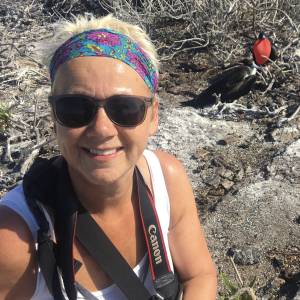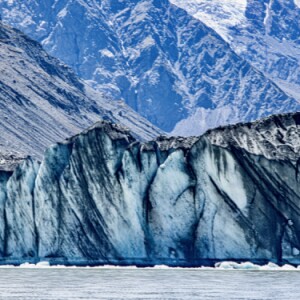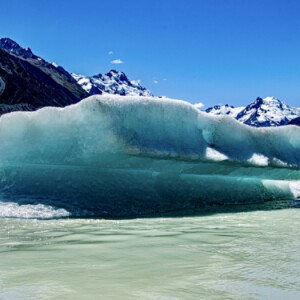Death Throes of an Ice Giant
We wake to another day of glorious alpine sunshine; the forecast clouds have clearly gone elsewhere - though seeing them skimming the top of ‘our’ mountains, I wonder whether they are clinging to the western slopes instead today
I have sometimes questioned the logic of this part of my itinerary - the long drive back to the Southern Alps; it seems crazy that we’re so close to where we stayed little more than ten days ago, but it’s wonderful to be back in the mountains again, and it seems so different from the other side.
This morning we have booked a trip to see the Tasman Glacier - a very different experience from seeing either the Franz Joseph or the Fox. However, when we reach the check-in desk at The Hermitage, we’re told that it’s been cancelled. To say we’re disappointed is an understatement; we’re transferred to the 12.30 departure, but we’re not optimistic. Apparently the ice build up on the lake is such that they’ve not been able to get the boats out for days, so a few more hours seems unlikely to see a change.
Still, we are in the most amazing location, and are blessed with glorious weather, so of course we will need to take one of the walks to fully appreciate our blessings. We opt for one of the shorter ones to Kea Point - after all, we need to be on hand if our glacier trip actually goes ahead.
It’s a beautiful morning walk through the still mountain air, through alpine vegetation rich with flowers and butterflies - and we can’t believe our luck to have Mt Cook so clear of cloud yet again. We reach the point, high on the lateral moraine walls - their size a reminder both of the size and strength of the Mueller glacier, and of its current drastic retreat. As we sit admiring the view, we chat with a couple from Sydney and first learn of the latest cyclone due to hit North Island - and how it may well impact on our return flight on Monday.
Right now, however, we have a Glacier Explorer trip to think about; against the odds, I have a voicemail confirming the 12.30 departure is actually on! We hot foot it back to base and report to The Hermitage from where a coach whisks us away to the nearby Tasman Valley and the start of our 20 minute walk to the lake, the final part down glacial moraine to the jetty.
The first sight of the lake is wonderful: an expanse of milky blue-grey on which float vast and various icebergs, and in the distance, the terminal wall of the fast retreating Tasman Glacier.
We join eight others in a jet boat with two guides, and set off for an hour of travelling around the lake, stopping to look at various icebergs with scientific explanations about ice formation, colour, age etc, moving with exhilarating speed between them. They range in size from vast irregular monsters - the one in my main consisting of a series of vast blocks of ice balancing precariously on an iceberg platform - to tiny ice-jewels sparkling in the chalky melt-water. Whilst there are some pristine and glistening in the magical blue-white of long-compressed glacial ice, many are a far cry from the purity of icebergs found in Antarctica for example. These are brutes, offcuts of the vast natural rock-destroying processes of glacial power, grey-black with the remnants of their destructive action, bruised and battered, grey and lined and ugly - yet still magnificent in their own way. They are the broken warriors of a dying glacier, for while Tasman might be the greatest of New Zealand’s ice giants, its days are clearly numbered, retreating at an average rate of 180 metres a year. There was no lake until the last years of the previous century; by 2008 the lake was over four miles long.
Quickly covering this new expanse of lake, we skim towards Tasman’s terminal face, from a distance, just a jagged dark grey line, but as we come closer, we can see the heavily indented blue-white cliff deeply scarred by lines of mineral black. Incredibly, it rises some 30 metres from the lake, below extending down 270 metres more. Small wonder, then, we keep a respectful distance as any calving could produce some treacherous results.
I’m so pleased that we’ve been able to see this - one of our main reasons for returning to the mountains. There’s such a sense of wonder seeing these shards of beauty and the evidence of the power of the ice, but there’s also an inevitable sense of doom. Less than two weeks ago we flew above this beautiful glacier, so radiant on Mt Tasman; yet here we see so much evidence of its impending doom. And yes, I know that there’s an irony to all this; our contribution to the climate crisis is part and parcel of this whole adventure. Like everything we’ve seen and witnessed on this trip, we recognise the real privilege that we have - to witness so much beauty. And the fact that by the end of the century - if not sooner - these glaciers will be gone, fills us with an intense sadness.
https://www.climatehotmap.org/global-warming-locations/tasman-glacier-new-zealand.html
Despite this - or because of this - it seems a fitting place to almost end our antipodean adventure; tomorrow we head for our last two days in Christchurch before returning home. The natural beauty we have seen here has links to ancient times, primeval forests unlike anything else on earth, beautiful bird life, seas rich with life. But witnessing the death-throes of these ice giants is a reminder of how little time we have to act to keep these treasures.
Many thanks for your generous response to yesterday’s Aoraki entry.
Today, my main is that towering block of ice on top of another iceberg - the conglomerate of structures seen in my first extra. Then there us the terminal wall, Lake Tasman full of ice bergs, and a couple of the more pristine bergs. Finally, I just couldn’t resist a collage of the stunning stained glass windows in the Aoraki Visitor Centre - such an amazing building.



Comments
Sign in or get an account to comment.


